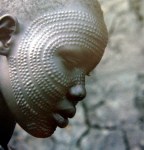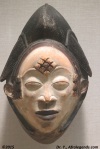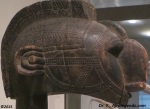
These days, many of my fellow African brothers and sisters sport tattoos of some European or foreign symbols on their skins. These symbols are usually alien to our cultures, traditions, thinking, and history. So I thought about talking about scarification, which could be called an “ancient” African culture of tattoos.
For starters, Africa has a rich culture of scarification. Many cite HIV, and ugliness as being the reason why they would not do scarification and why the practice has been abandoned. I neither agree nor disagree with them, but I would like to give a history of scarification and why, this is something to be cherished as part of our history, even if it is no longer practiced and/or needed today.

In the past, a woman or man would have scarification marks that will distinguish her/him from anyone else, tell her/his rank in society, family, clan, and tribe, and symbolize her beauty or strength. In some African tribes, it was like wearing your identity card on your face. True, some may hate that, but this was a mark of pride, not shame. In most African cultures, it was a major aesthetic and cultural component as can be seen on sculptures in museums around the world. Scarification patterns on sculptures are not only marks of beauty, but marks of one’s lineage as well, and in some cases protection against evil spirits. Lastly, in Africa like in Polynesia, scarification is more visible on darker skinned people than say, tattoos.

What is scarification? Scarification is the practice of incising the skin with a sharp instrument such as a knife, glass, stone, or coconut shell, in such a way as to control the shape of the scar tissue on various parts of the body. Cicatrisation is a special form of scarification where a gash is made in the skin with a sharp instrument, and irritation of the skin caused by applying caustic plant juices forms permanent blisters. Dark pigments such as ground charcoal are sometimes rubbed into the wound for emphasis. These cuts, when healed, form raised scars, known as keloids. The most complicated cicatrisation was probably found in the Congo Basin and neighboring regions, and among the Akan people of West Africa.

Scarification is a long and painful process, and a permanent modification of the body, transmitting complex messages about identity and social status. Permanent body markings emphasize social, political, and religious roles. Beautiful and complex designs depend on the artist’s skills but also on a person’s tolerance to pain. Facial scarification in West Africa was used for identification of ethnic groups, families, individuals but also to express beauty; scars were thought to beautify the body. It was also performed on girls to mark stages of life: puberty, marriage, etc. These marks assisted in making women more attractive to men, as the scars were regarded as appealing to touch as well as to look at, but also as testimony that women could withstand the pain of childbirth. Princesses in many places, including West Cameroon, used to sport amazingly beautiful and intricate marks. The sculpted face of Queen Idia of Benin Kingdom sports two marks on her forehead. For the Karo people of Ethiopia, men scar their chests to represent killing enemies from other tribes; women with scarred torsos and chests are considered particularly sensual and attractive.

Today, the art of scarification is changing in Africa, and can mostly be spotted on elders. Mostly because of fears of HIV transmission via blades, and also because of the shame encountered. It is a culture which was once loved and is now despised. Ironically, people in western societies go under the knife to perfect their bodies; they prefer to hide their scars (it is also not on their faces)! Moreover, with the advent of identification cards, the need for scarification has also reduced.
I just wanted us to cherish and not frown upon an ancient culture which had its purpose, and was an integral part of our society, history, and traditions. For more on scarification in African cultures, check out Ezakwantu.com and RandAfricanArt which have amazing images of scarification in Africa, and these articles on the Huffington Post, National Geographic, and Lars Krutak‘s article on the Bétamarribé people of Benin.


Pingback: AFRICAN BEAUTY MARKS-“Scarification: an ‘Ancient’ African Tattoo Culture”-from AFROLEGENDS.COM | BLACK IS BEAUTIFUL!
THIS IS GREAT! THESE ARE ACTUALLY AFRICAN BEAUTY MARKS ATI FAR MORE BEAUTIFUL THAN TATOOES!
LikeLike
I totally agree with you Yeye. Moreover, these marks also have a lot of meaning linked to our cultures, associated with them.
LikeLike
I have a question, so I am doing a project over scarification and im using this article but i have to give credit to the author of the article so what do you go by. Is it just Dr. Y. or something else
LikeLike
Just Dr. Y. . Aparna. Thanks for citing the article, and I am glad I could be of help.
LikeLike
Pingback: Review: “Carve The Mark” by Veronica Roth | Bibliodaze
Pingback: The purpose of (male) circumcision | One Tawny Stranger
Pingback: African Designers and Artists Inspired by Scarification
Pingback: 10 Tantalizing Tales Of Tattoos Throughout History | Friday News
Pingback: 10 Tantalizing Tales Of Tattoos Throughout History – Listverse – All Day Viral
Pingback: 10 Tantalizing Tales Of Tattoos Throughout History – GENIE NEWS
Pingback: 10 Tantalizing Tales Of Tattoos Throughout History – Viral Plus
Pingback: The History of Body Alterations – Mental Health Associated with Plastic Surgery
All this is great since I am a first generation with parents from Africa. But I just want to know why there are quotations around the word ancient. It is as if to say that African cultures are not ancient as opposed to other cultures. That may be petty, but I am a writer so I have my reasons.
LikeLike
Semoben, thanks for commenting and for visiting the blog. The quotes around the word ‘Ancient’ is just to put the emphasis on the fact that Scarification could be called compared to the modern Tattooing, and in that sense it is an ancient technique of tattooing.
LikeLike
I really appreciate Dr Y. For your effort on this info. I’m equally using it to form a talk on scarification for some students. God bless you sir.
LikeLike
Thanks Jimoh. I am so glad I could help.
LikeLike
That’s crazy! But the results are amazing! I think the scarification are beautiful.
LikeLike
This is good! i will appreciate more information on this topic.
LikeLike
Pingback: Carole Horn’s notes on Two Trains Running (with notes, links and annotations) – August Wilson's American Century Cycle
Pingback: BAM Practices: Scarification in Africa | Pop Culture Anthropology
Pingback: Tattoos, Scarification and Tribes – S.W.E
Pingback: BCM312 ASSESSMENT 1 – THE IDEAS BLOG – THE PLANET | Lily Carr
Thanks for the article. I didn’t know about the history of scarification in different cultures and the cultural identity with them.
LikeLike
This was beautiful and appreciated.
LikeLike
Yes indeed Dena… it was beautiful and appreciated. Thank you for your contribution!
LikeLike
Pingback: 7 Designers and Artists Inspired by Scarification - Atelier Fifty Five | Contemporary African Design
Reblogged this on African Heritage and commented:
Today, we will reblog our article on scarification, this ancient African Tattoo culture. This was much more than art work on skin… for many it was a way of identification (the ethnic group you belonged to), it signified a right of passage (boyhood to manhood, girlhood to womanhood, etc), marks of beauty and status, protection against evil spirits, and a rich tradition passed on from generation. So next time you think about tattooing yourself, remember the ancient ways and designs of yore.
LikeLike
Pingback: 7 Designers and Artists Inspired by Scarification - atelier | 55 - Contemporary African Design
Wowza
LikeLike
Pingback: Margin notes from Two Trains Running (04062021) – August Wilson's American Century Cycle
They need to bring this back and just adhere to safety and health regulations. This isn’t something to be frowned upon for this is pure culture rightness and deserves to be a protected right. My body mods I regard as spiritual and any mods in the future will be as well. These scarifications are not only stunning they also show spirit and thus can never be wrong.
Blessed Be )0(
LikeLike
Pingback: Notes on Two Trains Running (10.29.2018) – August Wilson's American Century Cycle